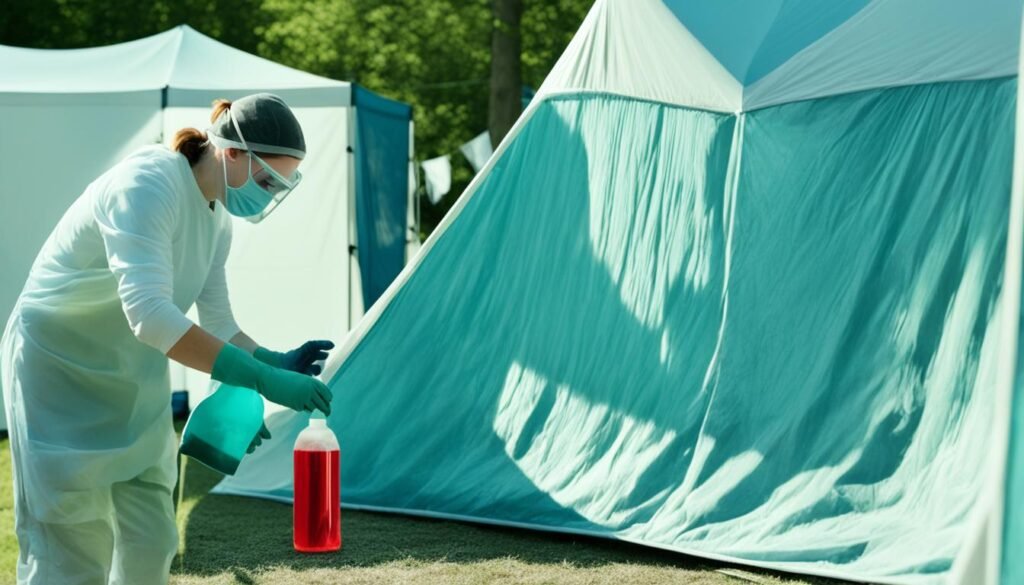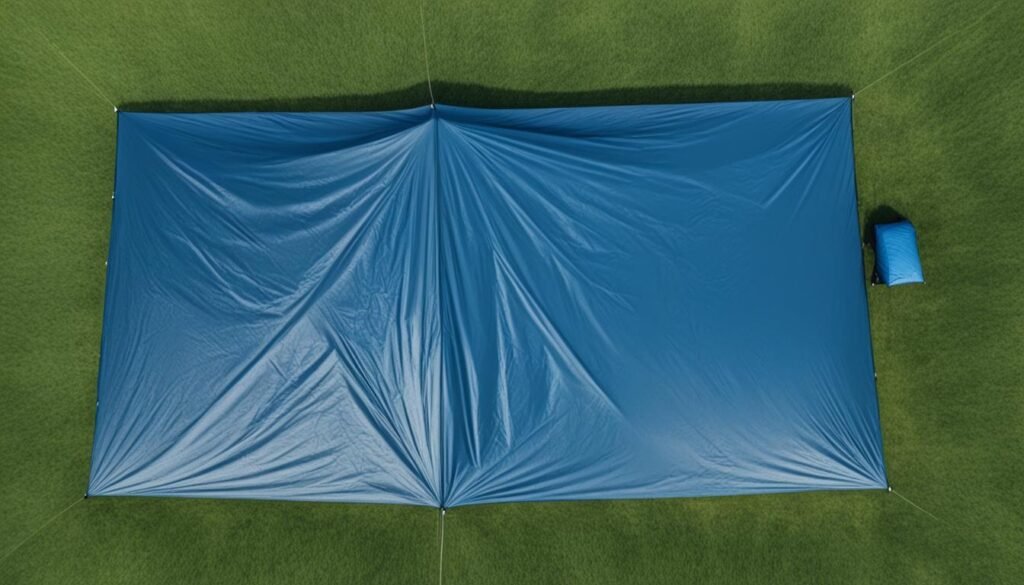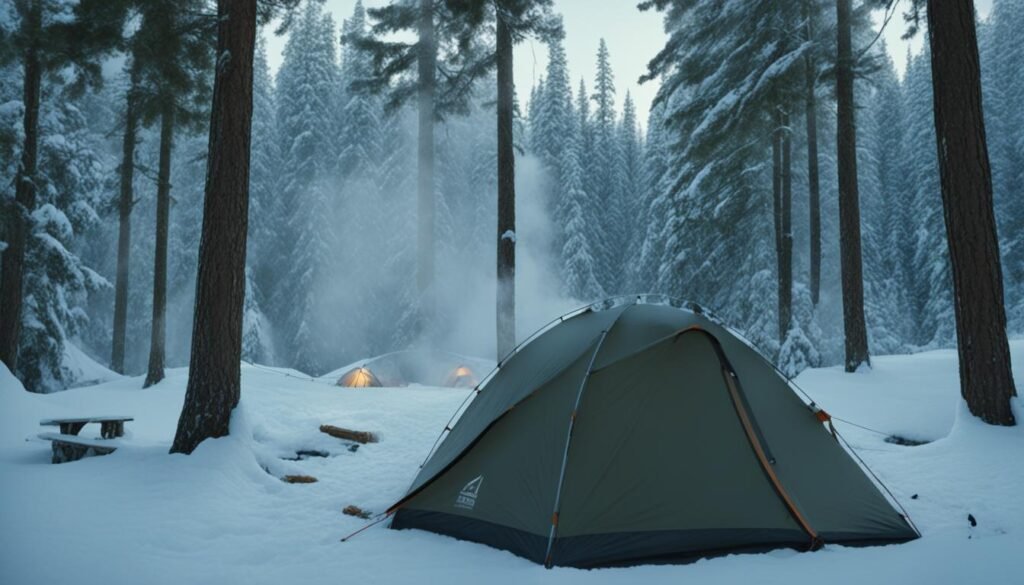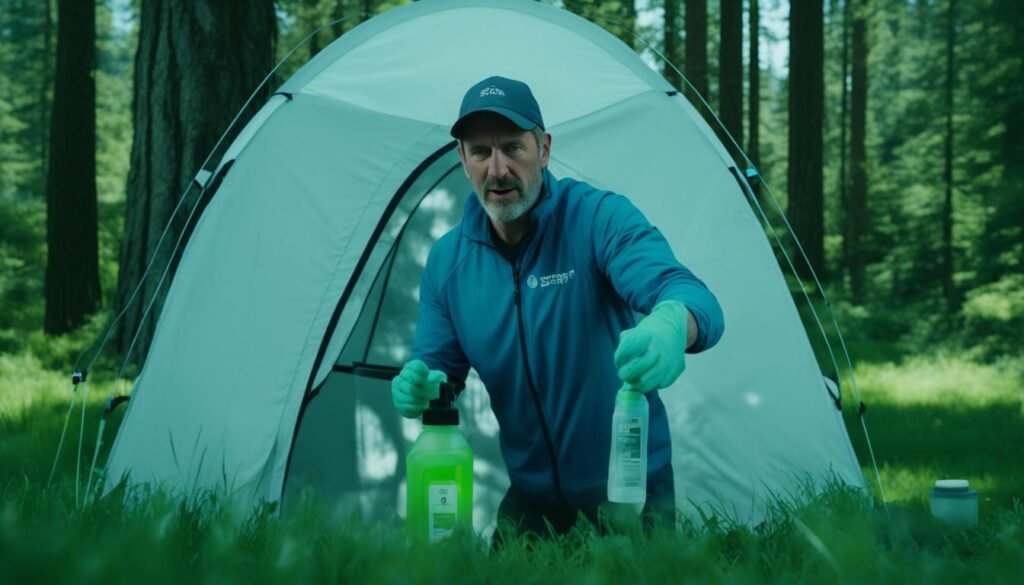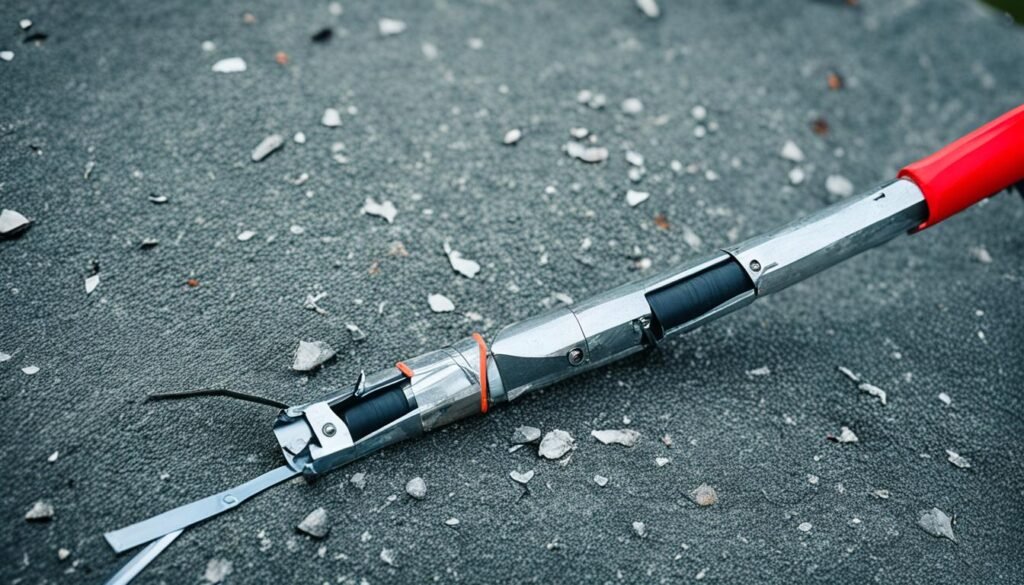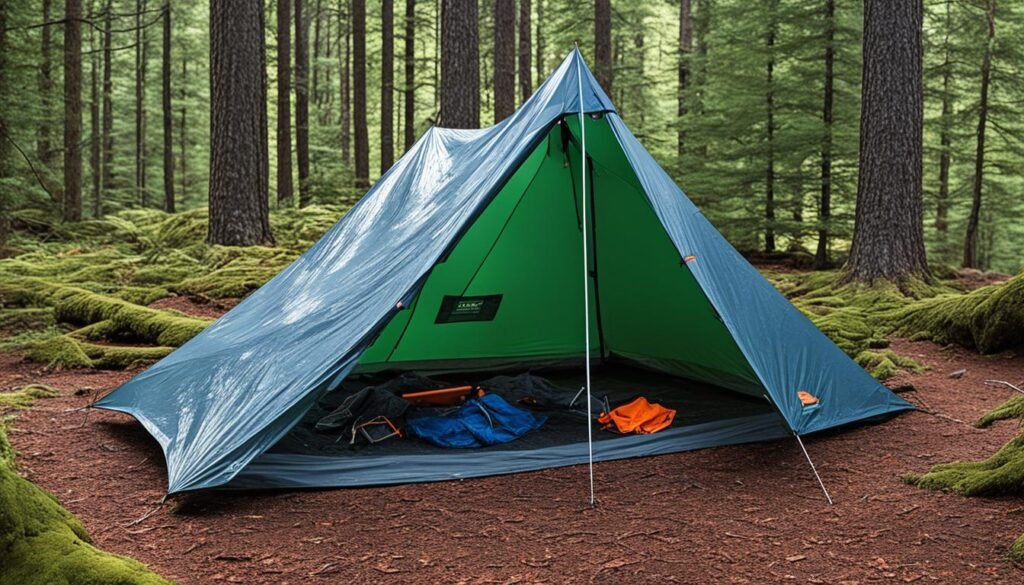Mold and mildew can quickly grow on wet tent fabrics, leading to a foul odor or mildew smell. But fear not! With the right techniques and some simple DIY steps, you can get your tent back in pristine condition and prevent mold growth in the future.
Key Takeaways:
- Regular tent maintenance and proper storage are crucial for preventing mold growth on outdoor equipment.
- Start by spot cleaning dirty areas with soap and water, then proceed to wash the entire tent with a mixture of cleaner and water.
- Deodorize your tent using a gentle odor eliminator to eliminate any lingering mold odors.
- If your tent has a polyurethane coating, remove the failing coating and apply a new one using a tent fabric sealant.
- Air dry your tent thoroughly and store it in a dry environment to keep it mold-free.
How to Remove Mold from Tent Fabrics
To ensure the longevity of your tent and maintain a healthy camping environment, it is essential to remove mold from tent fabrics promptly. Mold can not only cause unpleasant odors, but it can also damage the fabric and compromise the waterproofing capabilities of the tent. In this section, I will outline the steps to effectively remove mold from your tent and ensure it is ready for your next adventure.
Spot Cleaning Dirty Areas
The first step in removing mold from your tent is to spot clean any visibly affected areas. In a small bowl, mix together mild soap and water to create a cleaning solution. Dip a sponge or cloth into the solution and gently scrub the mold-infested areas. Be sure to focus on the spots where mold is most prevalent.
Pro Tip: Use a gentle touch when scrubbing to avoid damaging the tent fabric.
Submerging the Tent
For a thorough cleaning, it is recommended to submerge the entire tent in a tub filled with warm water and a specialized tent cleaner. Create a mixture of the cleaner and water according to the product instructions. Immerse the tent in the solution and use your hands to agitate the fabric, ensuring that all surfaces come into contact with the cleaner.
Pro Tip: Avoid scrubbing the underside of the tent fly to prevent damage to the waterproof coating.
Rinsing and Drying the Tent
After submerging the tent, remove it from the cleaning solution and rinse it thoroughly with clean water. Ensure that all soapy residue is completely removed. Once rinsed, allow the tent to air dry completely in a well-ventilated area. Hanging the tent or spreading it out on a clean surface can help expedite the drying process.
Deodorizing the Tent
If your tent still has lingering mold or mildew odors after cleaning, it is important to deodorize it. Choose a gentle odor eliminator specifically designed for use on fabrics. Follow the product instructions to apply the deodorizer to the entire tent, paying extra attention to areas where odors are concentrated.
Removing Sap
In addition to mold, you may encounter sap on your tent fabric, especially if camping under trees. To remove sap, gently dab a cloth or sponge soaked in isopropyl alcohol onto the affected areas. The alcohol will help break down the sap, making it easier to remove.
Summary
By following these steps, you can effectively remove mold from tent fabrics, ensuring a clean and safe camping experience. Remember to spot clean, submerge the tent, rinse thoroughly, air dry, deodorize, and remove sap as needed. With proper care and maintenance, your tent will continue to provide comfort and protection on all your outdoor adventures.
How to Deodorize a Moldy Tent
After cleaning the tent, you may still have stubborn mold and mildew odors. To deodorize a moldy tent, follow these steps:
- Fill a tub with water.
- Add a gentle odor eliminator to the water.
- Soak the tent in the odor eliminator mixture for a maximum of 5 minutes. Make sure to unzip all zippers and open tent flaps.
- Do not rinse the tent, but allow it to air dry completely.
The odor eliminator formula contains microbes that consume odor-causing bacteria in fabrics, effectively removing mold odors from the tent. This process will help eliminate musty smells and leave your tent fresh and odor-free.
Additional Tips for Deodorizing a Tent:
- You can also use the odor eliminator mixture to deodorize other outdoor gear or foul-smelling items.
- To prevent mold and mildew odors from recurring, store your tent in a dry environment and ensure it is completely dry before packing it away.
How to Remove PU Odors from Tents
If your tent has a polyurethane (PU) coating and emits a foul odor similar to vomit or urine, there are steps you can take to effectively remove the unpleasant smell.
- First, fill a tub with warm water and add a few drops of mild dish soap.
- Submerge the tent in the soapy water and let it soak for 2-3 hours.
- Gently scrub the failing PU coating off the tent using a brush. It’s recommended to use a mixture of isopropyl alcohol, water, and soap for this step.
- Remove any excessive residue by soaking it up with a dish towel.
- Once the old coating is successfully removed, apply a new PU coating to the tent using a tent fabric sealant such as Seam Grip TF.
- Allow the tent to air dry for 24 hours, ensuring proper ventilation.
- To reduce tackiness, sprinkle talcum powder on the new coating.
By following these steps, you can effectively remove PU odors from your tent, fix the PU coating odor, and treat a vomit smell in your tent. Remember, using a tent fabric sealant is crucial to restore the tent’s functionality and eliminate the unpleasant odor.
| Steps to Remove PU Odors from Tents |
|---|
| Fill a tub with warm water and mild dish soap. |
| Submerge the tent in the soapy water and let it soak for 2-3 hours. |
| Gently scrub the failing PU coating off the tent using a mixture of isopropyl alcohol, water, and soap. |
| Remove excessive residue with a dish towel. |
| Apply a new PU coating using a tent fabric sealant like Seam Grip TF. |
| Air dry the tent for 24 hours and sprinkle talcum powder on the new coating. |
Proper Tent Storage to Prevent Mold Growth
To ensure the longevity of your tent and prevent the growth of mold, proper storage is crucial. Follow these tent storage tips to keep your gear in pristine condition:
- Air dry your tent: After each trip, take the time to thoroughly air dry your tent. This will prevent any moisture from being trapped inside, which can lead to mold growth.
- Avoid storing a damp or wet tent: It’s essential to store your tent only when it is completely dry. Packing it away while still damp or wet creates the perfect environment for mold and mildew to flourish.
- Choose a dry and ventilated storage location: Find a dry and well-ventilated area to store your tent. Avoid storing it in a damp basement or attic, as these environments can promote mold growth. Instead, consider a closet, garage shelf, or dedicated gear storage area.
- Use a breathable storage bag: Instead of keeping your tent in the original packaging, invest in a breathable storage bag specifically designed for tents. These bags allow air to circulate, preventing moisture buildup and mold growth.
- Apply a UV protectant: To add an extra layer of protection against the sun’s harmful rays, consider applying a UV protectant spray to your tent. This will help maintain the tent’s color and prevent further sun damage, reducing the risk of mold growth.
By following these tent storage tips, you can significantly reduce the chances of mold growth and keep your tent fresh and ready for your next adventure.
Expert Tip:
“Proper tent storage is just as important as cleaning when it comes to preventing mold. Take the time to dry and store your tent correctly, and you’ll enjoy a mold-free camping experience for years to come.” – Julia Coleman, Outdoor Gear Expert
Cleaning a Dirty Tent: Essential Steps
Cleaning a dirty tent is an important part of tent maintenance. Whether you’ve just returned from a camping trip or noticed dirt and grime accumulating over time, giving your tent a good cleaning will not only make it look better but also help prolong its lifespan. Follow these essential steps to ensure your tent stays clean and ready for your next adventure.
- Gather the necessary equipment: Before you begin the cleaning process, gather all the equipment and supplies you’ll need. This includes water, soap, a tent or gear cleaner, a cloth or sponge, and a tub or large container.
- Brush off dirt and debris: Start by brushing off any loose dirt or debris from the surface of the tent. Use a soft brush or your hands to gently remove any dirt, leaves, or twigs that may have accumulated.
- Spot clean dirty areas: Next, spot clean any areas that are particularly dirty or stained. Use a mixture of mild soap and water, along with a cloth or sponge, to gently scrub the affected areas. Be careful not to scrub too hard or use harsh chemicals that could damage the tent fabric.
- Immerse the tent in sudsy water: Fill a tub or large container with warm water and add a suitable tent or gear cleaner. Immerse the tent in the sudsy water and let it soak for a few minutes. This will help to further loosen any dirt or grime that may be embedded in the fabric.
- Rinse thoroughly: After soaking, remove the tent from the tub and rinse it thoroughly with clean water. Make sure to rinse off all the soap and suds to prevent any residue from accumulating on the fabric.
- Dry the tent completely: Once rinsed, hang the tent up or lay it out to dry completely. It’s essential to ensure that the tent is thoroughly dried before storing it to prevent mold and mildew growth.
For tougher cleaning jobs or stubborn stains, you may need to consider deep-cleaning methods or specific cleaners designed for outdoor gear. Consult the manufacturer’s instructions or seek professional advice for guidance.
Remember, proper tent maintenance goes beyond just cleaning. It’s also essential to store your tent in a dry and well-ventilated area to prevent moisture buildup and the growth of mold or mildew. Additionally, regular inspections and quick cleaning of any dirt or stains can help keep your tent in excellent condition for years to come.
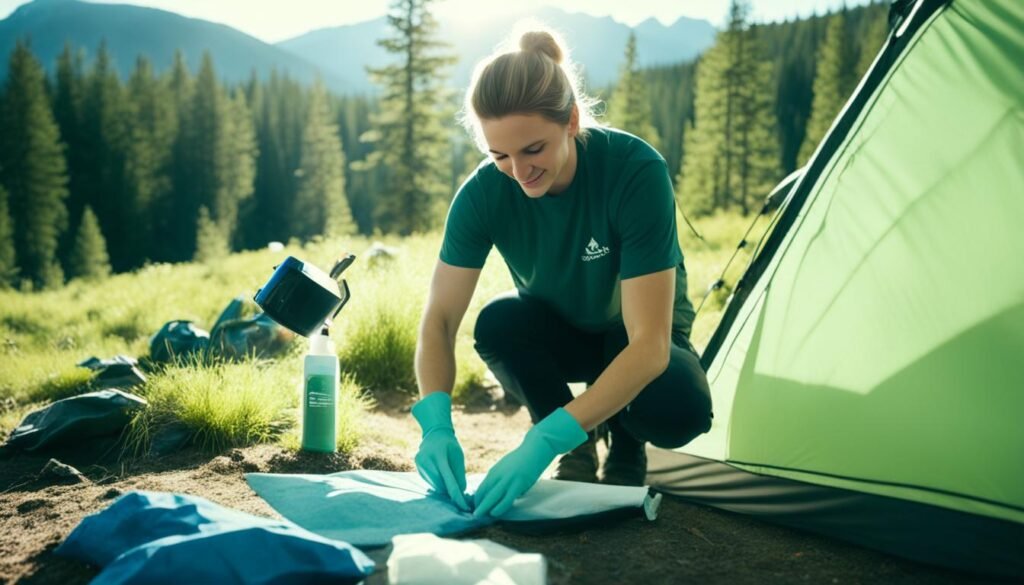
Recommended Cleaning Supplies
| Equipment/Supply | Description |
|---|---|
| Water | For rinsing and soaking the tent |
| Mild soap | Gentle on the tent fabric, yet effective for cleaning |
| Tent/gear cleaner | Specifically designed for cleaning outdoor gear |
| Cloth or sponge | For spot cleaning and gentle scrubbing |
| Tub or large container | For immersing the tent in sudsy water |
Spot Cleaning and Immersion for Tent Cleaning
When it comes to cleaning a dirty tent, spot cleaning and immersion are two effective methods that can help you remove dirt, stains, and grime from tent fabric. Whether you’re dealing with muddy footprints or food spills, these cleaning techniques can restore your tent to its former glory.
Spot Cleaning a Tent
Spot cleaning is perfect for tackling extra-dirty areas of your tent. To spot clean, start by mixing warm water with a gentle soap or tent cleaner. Gently scrub the dirty areas using a cloth or sponge, paying close attention to any stubborn stains. Rinse the area thoroughly with clean water and allow it to air dry.
If you’re dealing with tough stains like oil or grease, you can use a specialized stain remover designed for outdoor fabrics. Simply follow the instructions on the label and remember to rinse the area thoroughly after application.
Immersion Cleaning for a Deep Clean
For a deeper clean, immersion cleaning is the way to go. Fill a tub or large basin with water and add a tent cleaner product, following the manufacturer’s instructions for the recommended amount. Immerse your tent in the water and let it soak for the recommended time, allowing the cleaning solution to penetrate the fabric and loosen dirt and grime.
After soaking, gently agitate the tent in the water to release any trapped dirt. Once you’re satisfied with the cleaning, thoroughly rinse the tent with clean water to remove all soap and loosened dirt. Make sure to rinse until the water runs clear, indicating that all residue has been removed.
After rinsing, gently squeeze out the excess water from the tent and hang it up to air dry in a well-ventilated area. Avoid direct sunlight, as prolonged exposure to UV rays can damage the fabric.
Comparison of Spot Cleaning and Immersion Cleaning
| Spot Cleaning | Immersion Cleaning | |
|---|---|---|
| Method | Gently scrubbing specific areas with soap and water | Soaking the entire tent in a tub or basin with a tent cleaner product |
| Effectiveness | Effective for tackling small, localized stains or dirt | Thoroughly cleans the entire tent, removing dirt and grime |
| Time | Quick and easy process | Requires more time for soaking and rinsing |
| Suitability | Ideal for minor stains or specific areas | Great for overall cleaning and maintenance |
| Spot cleaning can be a convenient option for tackling small, localized stains or dirt on your tent. It’s a quick and easy process that can be done with simple soap and water. | On the other hand, immersion cleaning offers a more thorough cleaning experience by soaking the entire tent in a tub or basin with a specialized tent cleaner. It’s a great option for overall cleaning and maintenance. |
By combining spot cleaning and immersion methods, you can keep your tent clean and fresh, ensuring it’s ready for your next outdoor adventure. Remember to always follow the manufacturer’s instructions and take proper care of your tent to prolong its lifespan and functionality.
Techniques for Deep Cleaning a Moldy Tent
When dealing with mold in a tent, deep cleaning is necessary to eliminate the mold and prevent its return. There are two effective methods for deep cleaning a moldy tent: machine washing and hand washing.
Machine Washing
To machine wash a moldy tent, follow these steps:
- Step 1: Use a front-loading washing machine on a delicate cycle with cold water.
- Step 2: Add a non-detergent soap specifically designed for outdoor gear to the machine.
- Step 3: Place the tent in the machine and ensure it is spread out evenly.
- Step 4: Run the machine on a gentle cycle.
- Step 5: Once the cycle is complete, remove the tent from the machine.
- Step 6: Allow the tent to air dry completely before packing it away.
Machine washing is a convenient and efficient way to deep clean a moldy tent, ensuring that all traces of mold are removed.
Hand Washing
If you prefer to hand wash your moldy tent, follow these steps:
- Step 1: Mix a non-detergent soap with lukewarm water in a bucket or basin.
- Step 2: Lay the tent on a clean surface, such as a tarp or clean grass.
- Step 3: Dip a soft brush or sponge into the soapy water and gently scrub the tent fabric in a circular motion, focusing on areas with visible mold.
- Step 4: Rinse the tent thoroughly with clean water to remove all soap and loosened mold.
- Step 5: Allow the tent to air dry completely before packing it away.
Hand washing allows for more control and attention to detail, ensuring that every part of the tent is thoroughly cleaned.

Deep cleaning a moldy tent is crucial to maintaining its longevity and preventing the reoccurrence of mold. Whether machine washing or hand washing, these techniques will effectively remove deep-seated mold and restore your tent to a clean and safe condition.
Natural Remedies for Mold Removal
When it comes to removing mold from your tent, natural remedies can be a safe and effective solution. Two commonly used natural products for mold removal are vinegar and lemon juice, both known for their antimicrobial properties.
Vinegar:
Vinegar is a versatile and inexpensive natural cleaner that can effectively eliminate mold. To create a mold removal solution, mix equal parts distilled white vinegar and water in a spray bottle. Shake the bottle well to ensure the solution is thoroughly mixed.
When using vinegar for mold removal, follow these steps:
- Identify the areas of the tent affected by mold.
- Saturate a clean cloth or sponge with the vinegar solution.
- Gently scrub the moldy areas of the tent, making sure the vinegar solution comes into direct contact with the mold spots.
- Allow the vinegar solution to sit on the moldy areas for at least one hour.
- Rinse the tent thoroughly with clean water to remove any residual vinegar and dissolved mold.
- Air dry the tent completely before storage to prevent mold growth.
Lemon Juice:
Lemon juice is another natural product that can help remove mold from your tent. Combine lemon juice with salt to create a paste-like consistency. Salt acts as a gentle abrasive that helps break down mold.
Here’s how you can use lemon juice for mold removal:
- Mix fresh lemon juice and salt to form a paste.
- Apply the paste directly to the moldy areas of the tent.
- Gently scrub the mold spots using a soft cloth or sponge.
- Allow the lemon juice paste to sit on the tent for a few hours.
- Rinse the tent thoroughly with clean water to remove the lemon juice and dissolved mold.
- Ensure the tent is completely dry before storing.
Both vinegar and lemon juice offer natural alternatives to chemical-based mold removers. They are safe to use on tent fabrics, and their antimicrobial properties help kill mold spores effectively.
Remember to wear protective gloves and work in a well-ventilated area when using any cleaning solution, natural or otherwise. Additionally, always spot test a small, inconspicuous area of your tent fabric before applying any mold removal solution to ensure there is no adverse reaction.
Expert Tip:
“Natural remedies like vinegar and lemon juice can be effective for removing small amounts of mold from your tent. However, it’s important to note that they may not completely eliminate all traces of mold, especially if the infestation is severe. In such cases, it’s advisable to consult a professional mold removal service to ensure the complete eradication of mold from your tent.” – Dr. Sarah Green, Environmental Health Expert
By utilizing these natural mold removal solutions, you can effectively clean and maintain your tent, ensuring a mold-free camping experience.
Commercial Mold Cleaners for Tent Cleaning
In addition to natural remedies, there are commercial mold cleaners available for tent cleaning. These cleaners are specifically designed for use on fabric and can effectively remove mold. By using mold cleaners for tent cleaning, you can tackle tough mold and mildew stains and ensure a thorough and efficient cleaning process.
When using commercial mold cleaners, it’s important to follow the instructions on the cleaner bottle for proper use. Typically, this involves direct application to the affected areas of the tent. Make sure to wear protective gloves to prevent any skin irritation and ensure adequate ventilation in the cleaning area.
Before applying a commercial mold cleaner to the entire tent, it’s recommended to spot test a small area first to ensure compatibility with the fabric. This will help prevent any potential damage or discoloration to your tent.
When using commercial mold cleaners, it’s important to remember that they are formulated specifically for fabric and are designed to effectively remove mold and mildew stains. By incorporating commercial mold cleaners into your tent cleaning routine, you can ensure a thorough and effective cleaning process.
Keep in mind that while commercial mold cleaners can be highly effective, it’s always a good idea to follow up with proper drying and storage techniques to prevent mold growth in the future.
Using effective mold cleaners for outdoor gear, such as tents, is essential for maintaining their longevity and performance. By incorporating commercial mold cleaners into your tent cleaning routine, you can effectively remove mold, mildew, and odors, ensuring a fresh and clean outdoor experience.
Preparing for Tent Cleaning
Before cleaning your tent, it’s crucial to gather all the necessary cleaning materials and create a suitable cleaning area. By being prepared, you can ensure a smooth and efficient cleaning process. Here are the essential steps to take:
Gather the Cleaning Materials
To effectively clean your tent, you will need the following items:
- Mold cleaner or mild soap
- Water
- Scrubbing tools such as a brush or sponge
- Protective gloves
Having these materials on hand will make the cleaning process more convenient and efficient.
Set Up a Proper Cleaning Area
Choose a well-ventilated area to clean your tent. It can be outdoors or in a well-ventilated room. Ensure there is enough space to move around comfortably during the cleaning process. Open windows or use fans to improve air circulation, which will help your tent dry faster.
In addition, consider setting up a cleaning station equipped with a table or tarp where you can lay out your cleaning materials. This will help you stay organized and keep everything within reach.
Now that you are fully prepared, it’s time to move on to the actual cleaning process. Refer to the next sections for detailed instructions on how to clean and maintain your tent effectively.
Surface Cleaning for Moldy Tents
Surface cleaning is an essential step in effectively removing mold from a tent. Ensuring a thorough clean will help maintain the integrity of the fabric and eliminate potential health hazards. To successfully surface clean a moldy tent, follow these simple steps:
- Brush off dry mold and debris: Begin by gently brushing off any loose mold or dirt from the tent fabric. Use a soft brush or cloth to gently remove the surface contaminants.
- Prepare a cleaning solution: In a bucket, mix mild soap or tent cleaner with warm water to create a soapy solution. Avoid using harsh chemicals that might damage the fabric.
- Wipe down the tent surfaces: Dip a sponge or rag into the cleaning solution and gently wipe down all tent surfaces. Take care to cover all areas, including corners and seams, but avoid over-saturation.
- Rinse thoroughly: After wiping down the tent surfaces, rinse them thoroughly with clean water to remove any soap residue and loosened mold particles. This step is crucial to ensure the tent is clean and ready for future use.
Remember to allow the tent to air dry completely before storing it. Proper surface cleaning is essential for mold removal and maintaining the longevity of your tent.
Note: It’s important to note that surface cleaning alone may not eliminate all mold spores or deeply embedded mold. If you suspect a severe mold issue or persistent mold growth, it’s advisable to consult a professional for assistance.
Removing Mold Odors from a Tent
After cleaning a moldy tent, you may still have lingering mold odors. It’s essential to tackle these odors to ensure a fresh and pleasant camping experience. Here are some effective methods for removing mold odors from your tent:
- Air out the tent: Find a sunny spot to set up your tent and allow it to air out. Ultraviolet rays from the sun can help eliminate any residual mold spores and their associated odors.
- Ensure complete drying: Before storing or using the tent again, make sure it is completely dry. Moisture can contribute to mold growth and the development of musty odors. Set up the tent in a well-ventilated area to facilitate drying.
By following these steps, you can effectively eliminate musty odors and deodorize your moldy tent, ensuring a fresh and enjoyable camping experience.
Note: Proper mold prevention measures and regular tent maintenance play a crucial role in preventing mold growth and future odors. Refer to Section 14 for more information on preventing mold growth in tents.
Preventing Mold Growth in Tents
Proper storage and regular maintenance are key to preventing mold growth in tents. By following a few simple tips, you can maintain a mold-free tent and ensure it stays in great condition for your outdoor adventures.
1. Store Your Tent Properly
Always store your tent dry and in a breathable bag. This allows any residual moisture to escape and prevents mold from taking hold. Avoid storing your tent in damp or humid environments, such as a basement or garage. Instead, choose a cool, dry place with proper ventilation.
2. Regularly Inspect Your Tent
Regularly inspect your tent for any signs of mold or mildew. This includes checking all the seams, corners, and crevices. If you spot any mold or mildew, it’s essential to clean it immediately to prevent further growth. Use the cleaning methods outlined in previous sections to effectively remove mold from your tent.
3. Apply Waterproofing Treatment
To keep your tent dry and mold-free, apply a waterproofing treatment at least once a year. This helps to maintain the integrity of the tent fabric and prevent moisture from seeping in. Follow the manufacturer’s instructions for the specific waterproofing product you choose.
4. Practice Good Tent Hygiene
While camping, be mindful of keeping your tent clean and dry. Avoid bringing wet or damp gear inside the tent, as this can introduce moisture and contribute to mold growth. If you encounter wet or muddy conditions, use a tarp or groundsheet under your tent to provide an additional layer of protection.
| Prevention Tip | Description |
|---|---|
| Store your tent dry | Allow any residual moisture to escape by storing your tent in a breathable bag. |
| Avoid damp environments | Do not store your tent in damp or humid places, as this encourages mold growth. |
| Regularly inspect your tent | Check for any signs of mold or mildew and clean immediately if found. |
| Apply waterproofing treatment | Keep your tent dry and mold-free by applying waterproofing treatment at least once a year. |
| Practice good tent hygiene | Avoid bringing wet gear inside the tent and use a groundsheet for additional protection. |
By implementing these prevention tips, you can ensure that your tent remains mold-free and ready for your next camping adventure.
Conclusion
Mold in tents can be a common and frustrating problem, but with the right cleaning methods and proper maintenance, it can be effectively addressed. By following the steps outlined in this article, you can safely and effectively clean a tent with mold, remove mold odors, and prevent mold growth in the future. Remember to always prioritize proper storage and regular maintenance to keep your tent in great condition and mold-free.
Cleaning a tent with mold requires thorough spot cleaning, immersion cleaning, and deep cleaning techniques. Using natural remedies like vinegar or lemon juice, as well as commercial mold cleaners, can effectively remove mold from tent fabrics. Additionally, proper tent storage and regular inspection are essential for preventing mold growth in the first place. By following these steps, you can ensure that your tent remains clean, fresh, and ready for your next outdoor adventure.
Final thoughts on mold removal from tents: It is crucial to address mold issues promptly to prevent further damage to your tent and potential health risks. Mold can grow rapidly in damp environments, so it’s important to be proactive in preventing its growth. Regular cleaning and maintenance, along with proper storage, will help ensure that your tent remains mold-free and ready for your next camping trip. Remember, a little effort in tent cleaning and maintenance goes a long way in preserving the lifespan and enjoyment of your outdoor gear.
FAQ
How do I clean a tent with mold?
To clean a tent with mold, start by spot cleaning dirty areas with soap and water. Then, submerge the tent in a mixture of water and tent cleaner, hand wash the outer fabrics, and rinse thoroughly until all soapy residue is gone. Deodorize the tent with a gentle odor eliminator if needed.
How can I remove mold from tent fabrics?
Spot clean dirty areas with soap and water, then immerse the tent in sudsy water with a tent cleaner. Gently scrub the tent fabric, avoiding the underside of the tent fly. Rinse the tent thoroughly with water and air dry completely. Deodorize, if necessary.
What should I do to deodorize a moldy tent?
Fill a tub with water and a gentle odor eliminator, then soak the tent in the mixture for around 5 minutes. Unzip all zippers and open tent flaps to allow the odor eliminator to work. Do not rinse the tent, and let it air dry completely.
How can I remove PU odors from my tent?
Remove the failing/delaminating PU coating using a mixture of isopropyl alcohol, water, and soap. Apply a new PU coating using a product like Seam Grip TF. Air dry the tent for 24 hours and sprinkle talcum powder on the new coating to reduce stickiness.
What is the best way to prevent mold growth in tents?
Proper tent storage is essential. Always air dry your tent and store it in a dry, well-ventilated environment. Use a breathable storage bag instead of the original packaging. Apply a UV protectant on your tent and other outdoor gear to prevent sun damage.
What are the essential steps for cleaning a dirty tent?
Brush off any dirt or debris, spot clean dirty areas, and immerse the tent in sudsy water. Rinse thoroughly and air dry completely before storage. Consider using deep-cleaning methods or specific cleaners for tougher cleaning jobs.
Which techniques are effective for deep cleaning a moldy tent?
Deep cleaning can be done through either machine washing or hand washing. Use a front-loading washing machine on a delicate cycle or mix non-detergent soap with lukewarm water for hand washing. Rinse thoroughly and air dry completely.
Are there natural remedies for mold removal?
Yes, vinegar mixed with water can be used as a mold removal solution. Lemon juice mixed with salt can also be used as a paste to break down mold. Both vinegar and lemon juice have natural antimicrobial properties that help kill mold.
Can I use commercial mold cleaners for tent cleaning?
Yes, there are commercial mold cleaners specifically designed for use on fabric. Follow the instructions on the cleaner bottle for proper use. Wear protective gloves and ensure adequate ventilation when using these cleaners.
What should I do to prepare for tent cleaning?
Gather the necessary cleaning materials such as water, soap, tent/gear cleaner, and scrubbing tools. Set up the tent in a well-ventilated area with enough space for cleaning.
How do I perform surface cleaning for a moldy tent?
Gently brush off dry mold or debris from the tent fabric. Use a solution of mild soap and water to wipe down all tent surfaces, avoiding over-saturation. Rinse thoroughly with clean water to remove soap and loosened mold.
How can I remove mold odors from my tent?
Air out the tent in a sunny spot to allow ultraviolet rays to eliminate residual mold spores. Alternatively, set up the tent in a well-ventilated area and ensure it is completely dry before storage or use.
What can I do to prevent mold growth in tents?
Proper storage and regular maintenance are key. Always store your tent dry and in a breathable bag. Avoid storing tents in damp or humid environments. Regularly inspect your tent for signs of mold or mildew and clean it immediately if any is found.
How do I clean a tent that is dirty?
Gather cleaning supplies, brush off dirt or debris, spot clean dirty areas, and immerse the tent in sudsy water. Rinse thoroughly and dry completely before storing.
What are spot cleaning and immersion for tent cleaning?
Spot cleaning involves using soap and water to clean extra-dirty areas, while immersion cleaning entails submerging the tent in a tub filled with water and tent cleaner. Spot cleaning is for smaller areas, while immersion is for a deeper clean.
Are there techniques for deep cleaning a moldy tent?
Yes, deep cleaning can be done through machine washing on a delicate cycle or hand washing with non-detergent soap and lukewarm water. Rinse thoroughly and air dry completely.
Are there natural remedies for mold removal?
Yes, vinegar mixed with water can be used as a mold removal solution, and lemon juice mixed with salt can be used as a paste. Both have natural antimicrobial properties that help kill mold.
Can I use commercial mold cleaners for tent cleaning?
Yes, there are commercial mold cleaners designed for fabric. Follow the instructions on the cleaner bottle and spot test a small area before using it on the entire tent.
What should I do to prepare for tent cleaning?
Gather cleaning materials, set up a well-ventilated area, and ensure you have enough space for cleaning.
How do I perform surface cleaning for a moldy tent?
Brush off dry mold or debris, then use a solution of mild soap and water to wipe down all tent surfaces. Rinse thoroughly with clean water to remove soap and loosened mold.
How can I remove mold odors from my tent?
Air out the tent in a sunny spot to eliminate residual mold spores. Alternatively, set up the tent in a well-ventilated area and ensure it is completely dry before storage or use.
What can I do to prevent mold growth in tents?
Proper storage is essential. Always air dry your tent and store it in a dry, well-ventilated environment. Use a breathable storage bag and apply a UV protectant to prevent sun damage.

